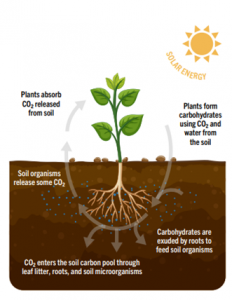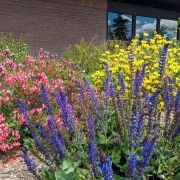Carbon Gardening: A Dirt Simple Solution to Climate Change
Picture this: you’re standing in the bathroom, watching the faucet gushing water into the bathtub. Suddenly, the bathtub is overflowing, and water is starting to flood your bathroom. Naturally, you turn off the faucet, the water stops flowing, and the floodwater stops rising. Phew! One problem down – but there’s still the issue of your flooded bathroom. Every time you use the bathtub faucet, the flooding will get worse, unless you figure out a way to deal with all that excess water and the problem that created it.
| Graphic provided by StopWaste.org |
 So, what does this have to do with climate change? You may have heard the word “sequestration” before. Sequestration is part of the carbon cycle (here’s a refresher on the carbon cycle) during which plants store carbon atoms in their biomass – their roots, trunks, stems, branches and leaves – as well as in the ground.
So, what does this have to do with climate change? You may have heard the word “sequestration” before. Sequestration is part of the carbon cycle (here’s a refresher on the carbon cycle) during which plants store carbon atoms in their biomass – their roots, trunks, stems, branches and leaves – as well as in the ground.
Activities that emit carbon – like burning fossil fuels, deforestation and land degradation – are like the faucet flooding our bathroom (the atmosphere) with water (or in this case, carbon dioxide or CO2). The plants and soil organisms that drive carbon sequestration are like the mop and bucket that can safely remove the excess. With mop in hand, we can get that water back to a manageable level. The Rodale Institute, an early champion of agricultural carbon sequestration, claims, “If we can increase the amount of carbon we have stored in our soils around the world by 0.4% per year, we could absorb all the excess carbon we currently emit.”
Much of the conversation around carbon sequestration involves restoring forests, wetlands, ranchlands, mangrove and kelp forests, and so on. Where does that leave those of us who live and tend landscapes in urban, suburban and semi-rural communities?
Enter carbon gardens. A carbon garden is a landscape that draws down and stores more carbon from the air than it releases into the air. Here is a simple explanation: when you build healthy soil, you’re sequestering carbon, but it also involves the materials you bring into your garden from outside and the way you maintain it. Building healthy soil has immense benefits beyond slowing down climate change, of course. Having more organic matter – that is, more carbon – in soil means healthier soil. Healthier soil means healthier, more productive and disease resistant plants. Healthier plants make for better habitat for wildlife, and for more beautiful gardens. Healthy, carbon-rich soil can store more water, helping to minimize drought impacts. It also needs fewer inputs like harmful synthetic fertilizers, which not only saves you time, money and energy, but also helps to protect the Russian River Watershed!
Okay, on to the big question: how do you grow a carbon garden? Here are 8 easy steps to get you growing…
- Minimize soil disturbances – there are trillions of soil organisms living in healthy soil. When we disturb them, CO2 is released. Let them thrive in peace by minimizing tilling and digging
- Cover your soil – leaving exposed soil allows it to dry out and be eroded by wind and water. Instead, cover it with living plants AND
- Apply compost and mulch – Mulch and compost protect soil, and they add more organic matter and nutrients to it as they decompose!
- Plant biodiversity – plants thrive in diverse communities, just like people! You want a diversity of regionally appropriate species, but also of plant types — trees, shrubs, grasses and so on. Here is a flyer for help with selecting Russian River-friendly plants https://www.rrwatershed.org/wp-content/uploads/2016/03/RRWA_River-Friendly-Plants_FINAL.pdf
- Plant CA natives – native species have a deep relationship with local soils. Bonus points for native trees, shrubs and woody perennials
- Water properly – just like us, plants and soil are at their best when properly hydrated. Be sure to use plants that thrive in our climate and group them by water needs to make watering easier and to avoid overwatering.
- Avoid synthetic chemicals and fertilizers – these inputs will deteriorate your soil’s health and make soils more dependent on their use in the future. They can also cause pollution of nearby waterways and habitat downstream from your garden during storm events. Garden pests can be controlled through less toxic integrated pest management. Our Water, Our World is an integrated pest management program available in many local hardware stores and nurseries.
- Avoid external inputs – ideally, a carbon garden is what we call a closed-loop system. Everything it needs to survive and thrive comes from within! Make your own compost! Use all those fallen leaves and plant trimmings as mulch! Get creative!
This article was authored by Connor DeVane, of Daily Acts, on behalf of RRWA. RRWA is an association of local public agencies in the Russian River Watershed that have come together to coordinate regional programs for clean water, habitat restoration, and watershed enhancement.




